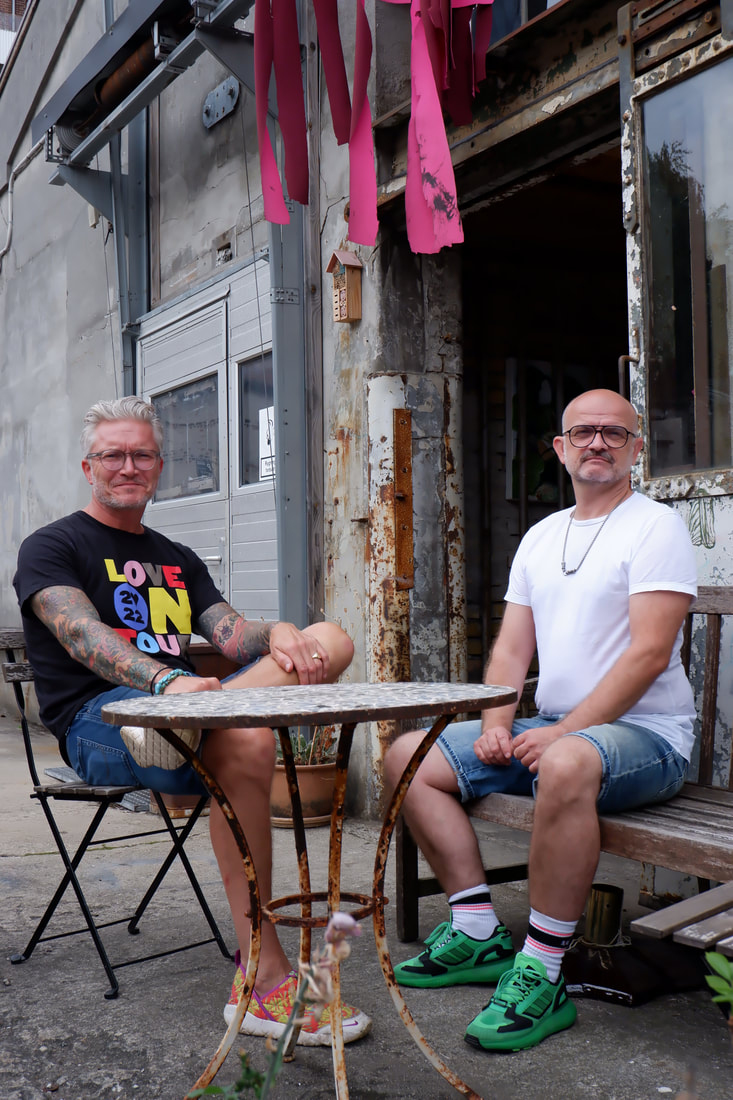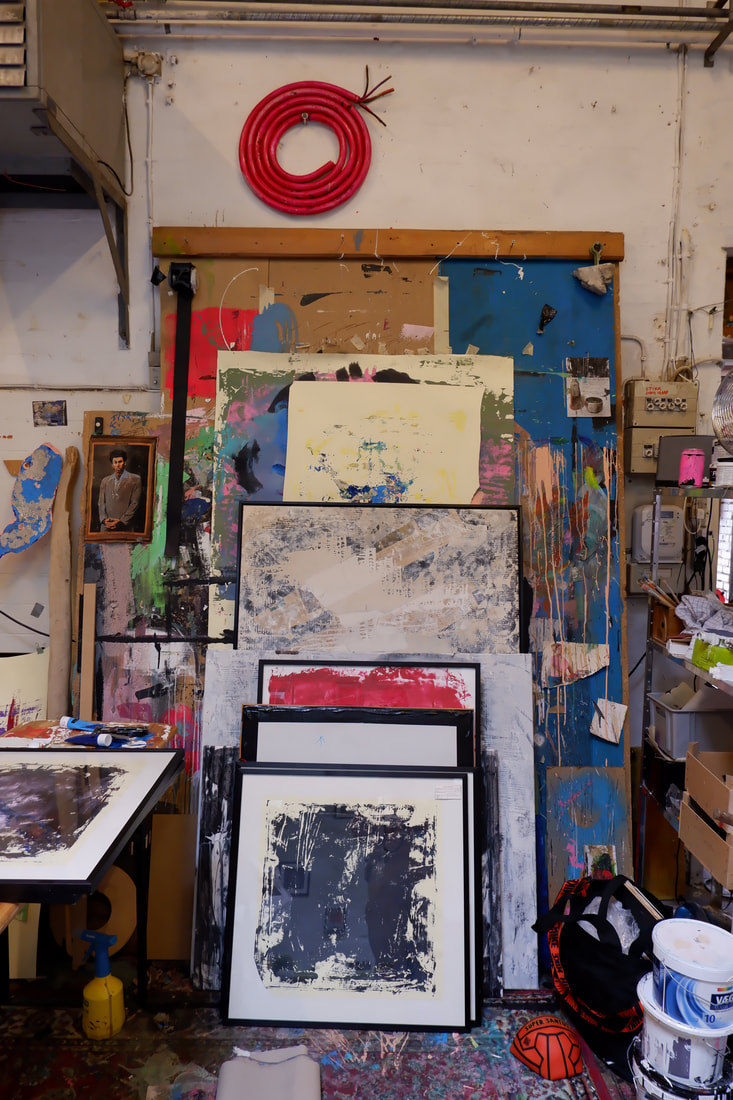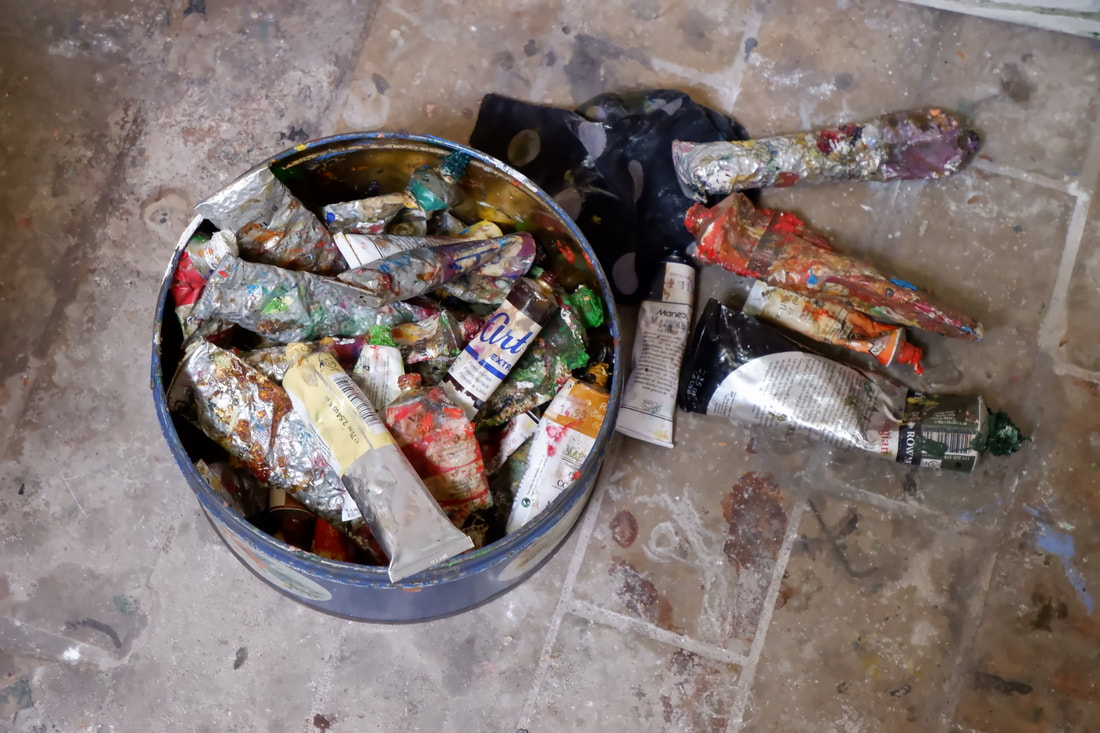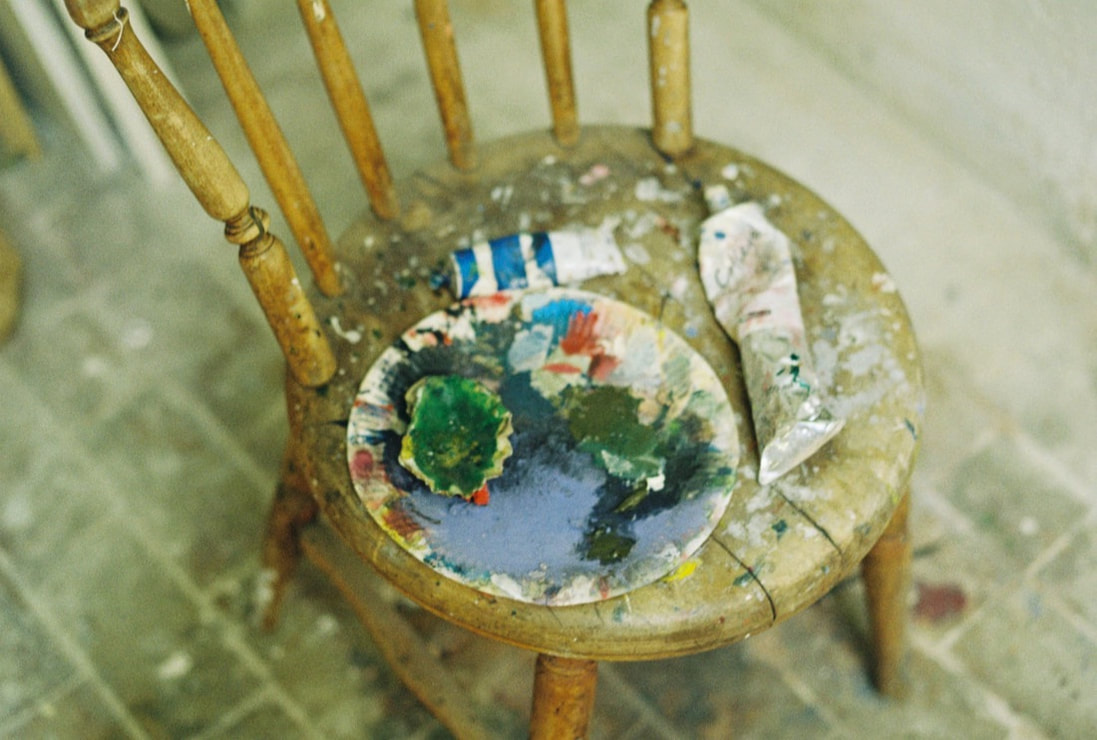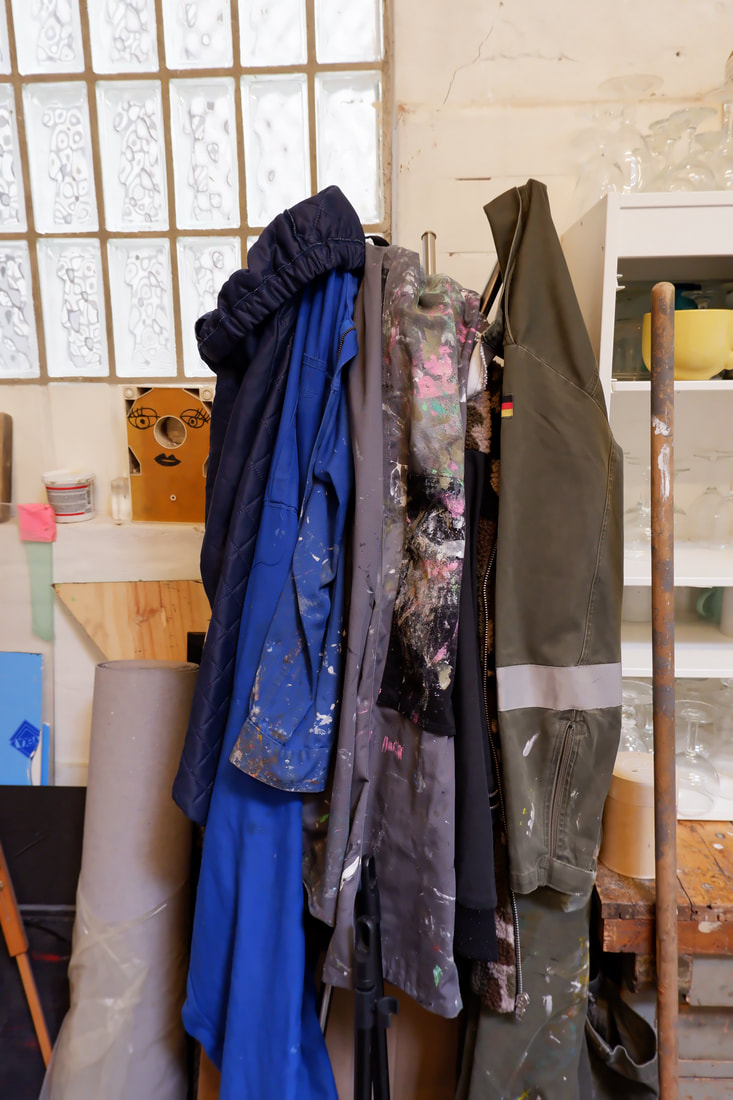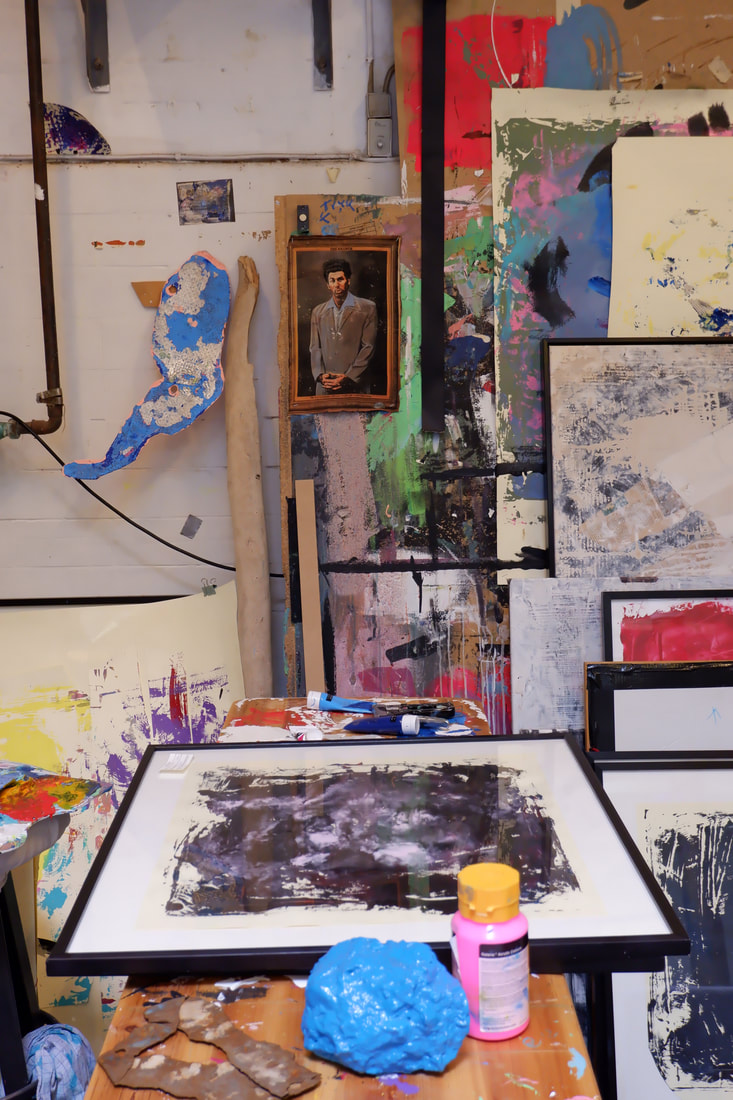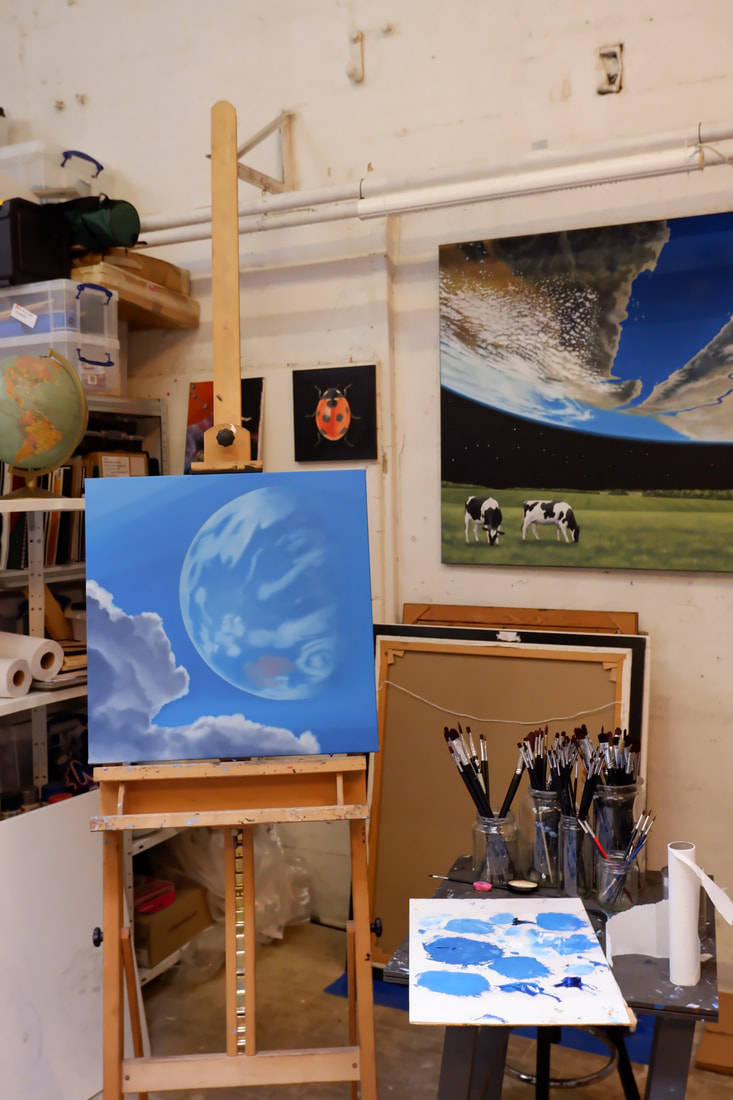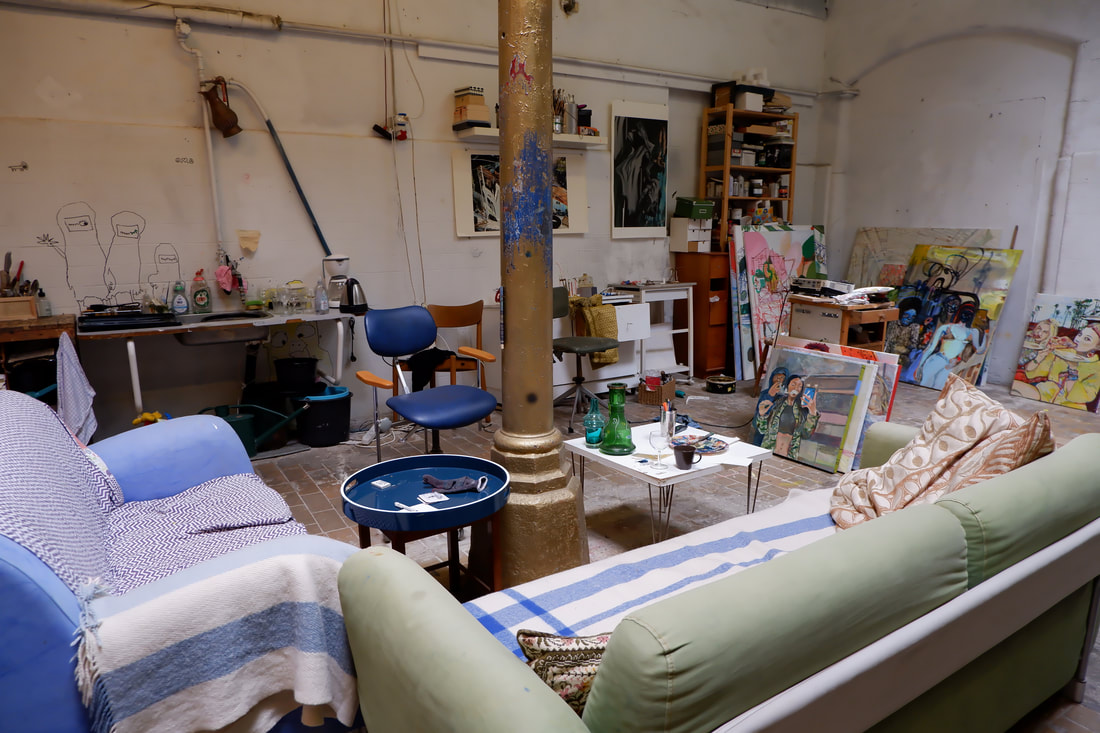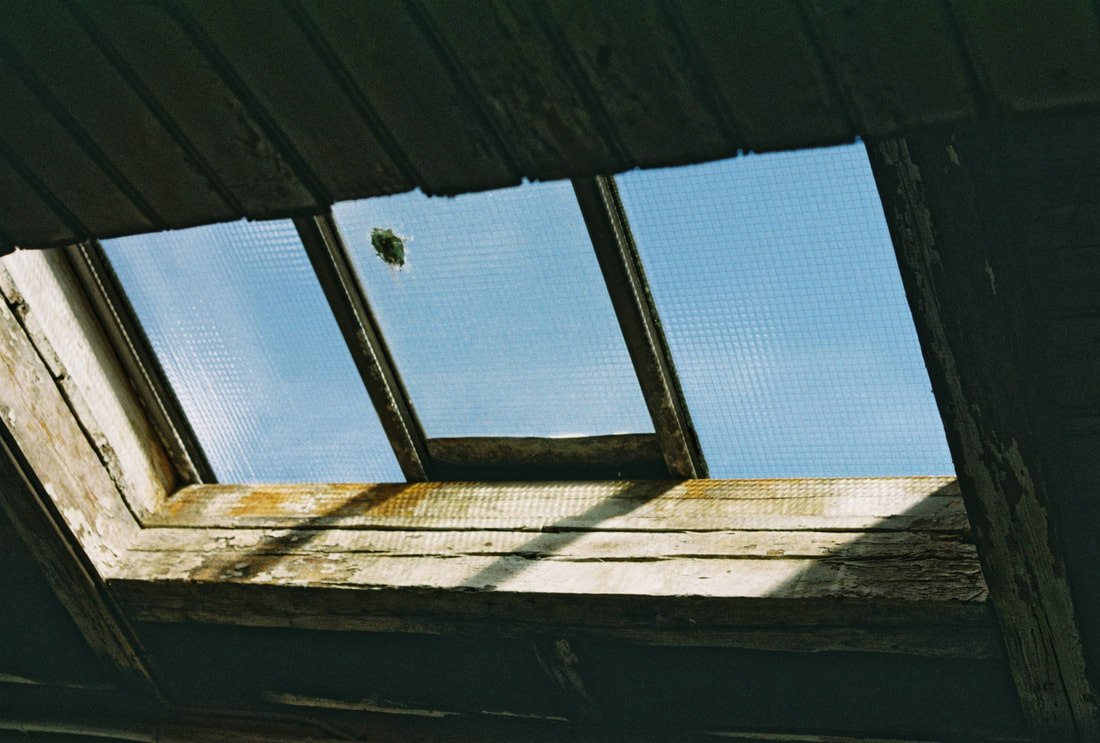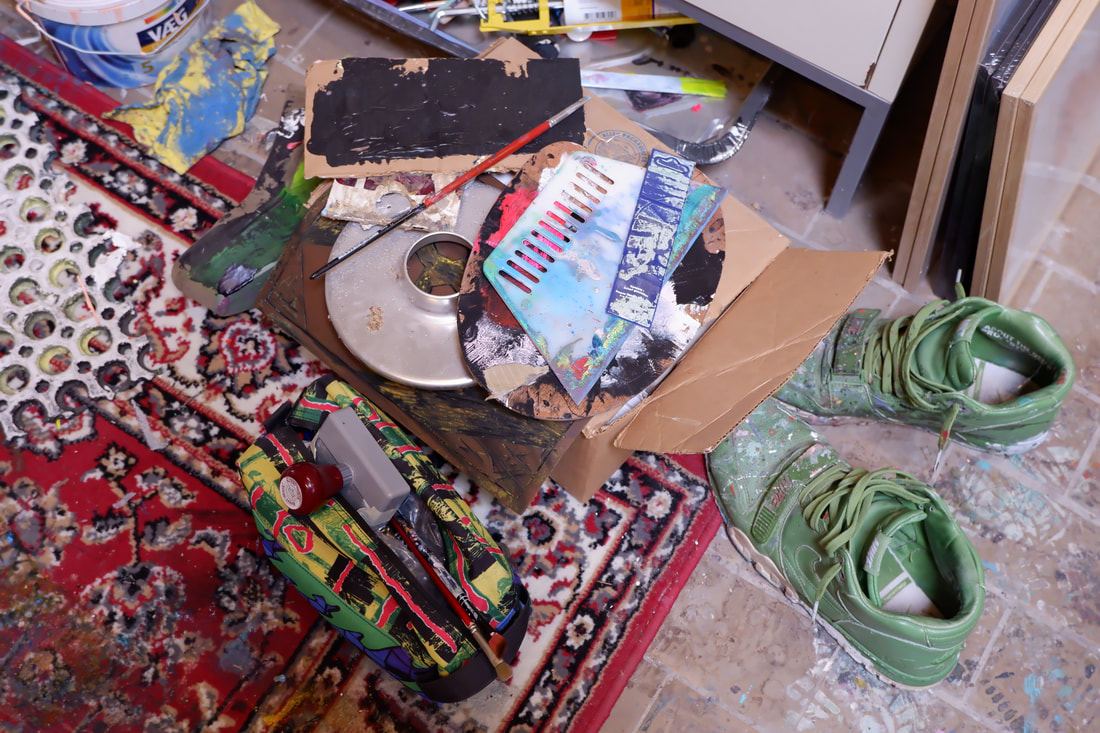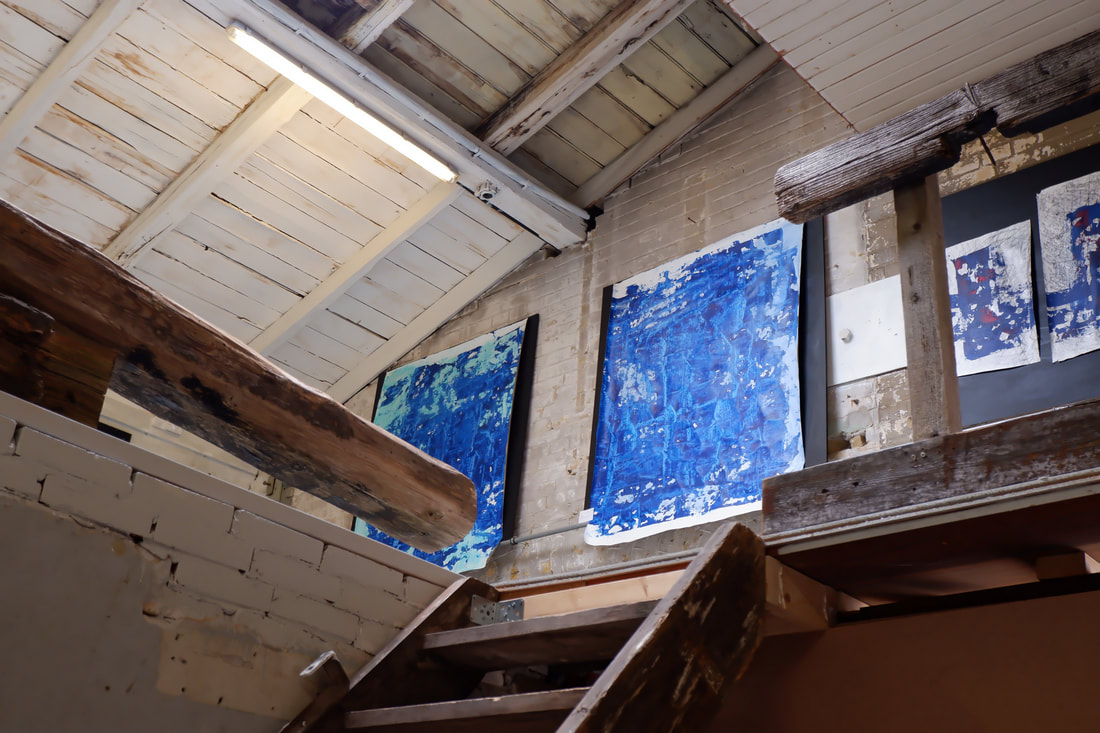Visiting Artists Jonas Sckerl and Jan Bo Vinter Poulsen from Studio 154H
Text and photography by Nora Benz | September 2022
Once an old slaughter house, Jægergårdsgade 154H near Sydhavnen has turned into a lively studio space shared by four Danish artists working with and alongside each other. Articulate paid Jonas Sckerl and Jan Bo Vinter Poulsen, the male part of Studio 154H, a visit in their studio in Aarhus.
How did Studio 154H come about?
Jan: The free space where our studio is now, emerged as a sort of left-over space. After closing the slaughter house which was located here, the space was made available for rent for small businesses and creative people. It has been used for various purposes like music, art studios and the like. Since 1984, I think, it has been a painting studio and was transformed by several painters who have been here.
Jan: The free space where our studio is now, emerged as a sort of left-over space. After closing the slaughter house which was located here, the space was made available for rent for small businesses and creative people. It has been used for various purposes like music, art studios and the like. Since 1984, I think, it has been a painting studio and was transformed by several painters who have been here.
Did the four of you know each other before moving into this studio?
Jan: No. It has actually grown out of an individual artist’s need for a space to work. I, for instance, looked a lot online for studio spaces until I found the contact for this place. I was so lucky that there was free space. Before moving in, we did an interview to see if it was possible for us to share the space. We are lucky that it is such a big space, that takes the edges off. And that we have very different working hours also helps a lot. It’s not so often that we are all here at the same time.
Jonas: That’s actually very nice. It’s quite random who is here at what time. We don’t arrange when we are here, but just come whenever we feel like it. And if I come to the studio and there is someone here, that’s nice, and if not, that’s nice, too. When we have collaborations and exhibitions, we meet up and plan how to do it.
Jan: I think most of us have periods in which we work quite intensely, during which we stay and work in the studio until late. And then during the summer holiday, we are not here that much.
Jan: No. It has actually grown out of an individual artist’s need for a space to work. I, for instance, looked a lot online for studio spaces until I found the contact for this place. I was so lucky that there was free space. Before moving in, we did an interview to see if it was possible for us to share the space. We are lucky that it is such a big space, that takes the edges off. And that we have very different working hours also helps a lot. It’s not so often that we are all here at the same time.
Jonas: That’s actually very nice. It’s quite random who is here at what time. We don’t arrange when we are here, but just come whenever we feel like it. And if I come to the studio and there is someone here, that’s nice, and if not, that’s nice, too. When we have collaborations and exhibitions, we meet up and plan how to do it.
Jan: I think most of us have periods in which we work quite intensely, during which we stay and work in the studio until late. And then during the summer holiday, we are not here that much.
How much do you actually work together and collaborate?
Jan: We don’t produce a lot of collective art. We are rather working alongside each other. But working like that does affect us of course. We are affected by each others’ works but we don’t produce art together.
Jan: We don’t produce a lot of collective art. We are rather working alongside each other. But working like that does affect us of course. We are affected by each others’ works but we don’t produce art together.
What role does feedback play in this regard? Do you seek for feedback among each other?
Jonas: For me personally it varies. Sometimes I have pressing questions about something I am working on and then I ask someone who is here. But perhaps we could seek more feedback from each other because it is always interesting to hear the opinion of someone else.
Jan: I think when we are here, we do critique each other. But, yeah, it could be more. I mean, we actually have a lot of collective knowledge we could share. And I think that is the advantage of a shared studio, that you can exchange some of that knowledge.
Jonas: Yeah, that’s also what is so nice about this area. There are a lot of interesting people living around who do a lot of different things; that gives a nice atmosphere.
Jonas: For me personally it varies. Sometimes I have pressing questions about something I am working on and then I ask someone who is here. But perhaps we could seek more feedback from each other because it is always interesting to hear the opinion of someone else.
Jan: I think when we are here, we do critique each other. But, yeah, it could be more. I mean, we actually have a lot of collective knowledge we could share. And I think that is the advantage of a shared studio, that you can exchange some of that knowledge.
Jonas: Yeah, that’s also what is so nice about this area. There are a lot of interesting people living around who do a lot of different things; that gives a nice atmosphere.
What are, in your opinion, the greatest benefits of having a shared studio space?
Jonas: The main advantage is that you are not alone all the time. It is also nice to sometimes do stuff together but also work individually. And it’s great to have the opportunity to ask if anyone is up for a collaboration for an exhibition. Then we can make it work together.
Jan: I think it’s quite funny because we are all rather introvert artists when we produce our art but when we are together that breaks things up. That’s what I really like about sharing a studio.
Jonas: What is also very interesting and funny is that when we open up our workspace and the gallery to invite our friends, the people who come down here are very diverse because we four are so different as artists.
Jonas: The main advantage is that you are not alone all the time. It is also nice to sometimes do stuff together but also work individually. And it’s great to have the opportunity to ask if anyone is up for a collaboration for an exhibition. Then we can make it work together.
Jan: I think it’s quite funny because we are all rather introvert artists when we produce our art but when we are together that breaks things up. That’s what I really like about sharing a studio.
Jonas: What is also very interesting and funny is that when we open up our workspace and the gallery to invite our friends, the people who come down here are very diverse because we four are so different as artists.
And what are drawbacks?
Jan: As in life there are always social clashes. You need to be considerate. It’s always difficult to be considerate but we get to practice that.
Jonas: I personally could also use some more space.
Jan: As in life there are always social clashes. You need to be considerate. It’s always difficult to be considerate but we get to practice that.
Jonas: I personally could also use some more space.
How does the surrounding of Studio 154H in particular and Aarhus in more general terms influence your work?
Jan: The joy of being in a facility relatively in the center of the city of Aarhus is amazing. Usually something like this is pushed to the suburbs or outskirts of a city. So for us, to actually be in the city, as all our works also relate to the city, is important. At some point, we won’t be able to be here anymore because this space runs on a temporary lease. But I think it is important that there are artists in the city. For us it is very important that we are close to the city and it is also one of the joys that we don’t have to travel far.
Jonas: I also think this environment, the whole area, is fantastic. For me it is so relaxing and inspiring to be here.
Jan: This area really generates a lot of life and culture for the city. For me it is also very simple, I paint people. So I look around at the people and these are the people I paint. So wherever I go I see different people and this is directly translated into my work. What space I am given also influences what materials I can work with. I used to work a lot with paper because I have been squeezed in small spaces and didn’t always have my own studio. So for me, having more space allows me to get back to canvases and bigger media which I love.
Jonas: I work a lot with my intuition and in order to be able to do that I need to be relaxed. This surrounding relaxes my mind. What also plays a role for me is that when I go out and look to the left, I see the raw industrial buildings and the industry at the harbor. That’s so fantastic, it really relaxes and inspires me.
Jan: The joy of being in a facility relatively in the center of the city of Aarhus is amazing. Usually something like this is pushed to the suburbs or outskirts of a city. So for us, to actually be in the city, as all our works also relate to the city, is important. At some point, we won’t be able to be here anymore because this space runs on a temporary lease. But I think it is important that there are artists in the city. For us it is very important that we are close to the city and it is also one of the joys that we don’t have to travel far.
Jonas: I also think this environment, the whole area, is fantastic. For me it is so relaxing and inspiring to be here.
Jan: This area really generates a lot of life and culture for the city. For me it is also very simple, I paint people. So I look around at the people and these are the people I paint. So wherever I go I see different people and this is directly translated into my work. What space I am given also influences what materials I can work with. I used to work a lot with paper because I have been squeezed in small spaces and didn’t always have my own studio. So for me, having more space allows me to get back to canvases and bigger media which I love.
Jonas: I work a lot with my intuition and in order to be able to do that I need to be relaxed. This surrounding relaxes my mind. What also plays a role for me is that when I go out and look to the left, I see the raw industrial buildings and the industry at the harbor. That’s so fantastic, it really relaxes and inspires me.
Little change in topic: What are bad creative habits you’d like to stop?
Jan: I probably overspend on materials. I have a constant fear of not having enough of the right materials and colors. Unfortunately, not everything is available to buy here in Aarhus. So when I travel, I overstock on stuff, it’s almost hoarding. I just hate to run out of the material I like to work with in that moment.
Jonas: I think perhaps I am too messy. Sometimes I think it would help my work if I cleaned up. But at the same time it also feels like freedom not to do it. So I am rather ambivalent about it.
Jan: I probably overspend on materials. I have a constant fear of not having enough of the right materials and colors. Unfortunately, not everything is available to buy here in Aarhus. So when I travel, I overstock on stuff, it’s almost hoarding. I just hate to run out of the material I like to work with in that moment.
Jonas: I think perhaps I am too messy. Sometimes I think it would help my work if I cleaned up. But at the same time it also feels like freedom not to do it. So I am rather ambivalent about it.
How do you keep yourselves going when you have a creative or motivational low?
Jan: I simply have the rule to make painting a daily thing. I am a strong believer in the sketch book. Even on days I don’t feel like working, I know that it is good for me. It’s an important outlet. Jonas: I don’t have a systematic approach like that. I try to do stuff also at home and when I am traveling I use a sketchbook. I also write down ideas and when I find materials I take them home. And usually I just start painting and then the ideas grow.
Jan: I simply have the rule to make painting a daily thing. I am a strong believer in the sketch book. Even on days I don’t feel like working, I know that it is good for me. It’s an important outlet. Jonas: I don’t have a systematic approach like that. I try to do stuff also at home and when I am traveling I use a sketchbook. I also write down ideas and when I find materials I take them home. And usually I just start painting and then the ideas grow.
Do you usually work on multiple works at the same time or rather on one after another?
Jan: I do like to have multiple things going on at the same time.
Jonas: Me too.
Jan: Which is not very structured. But I don’t know if I could do it any other way, like to finish one thing and then put the next work in front of me. I mean, I probably could, but that’s a commission. But do I love doing commissions? No, not as much as creating my own stuff.
Jonas: I think it is nice to work on several pieces at a time because one picture speaks to me and I can see something in it. Either that it’s done or at least that I am on the right path. And this is also something I can always see in the other picture. Working on one picture actually helps me to work on the other one. It’s like communication.
Jan: What I also sometimes do with commissioned work is that I create two versions to have a selection to choose from. In that way I can decide which one is the final work.
Jonas: That’s actually a very good idea. Then there is less pressure
Jan: Exactly, because the commission can cause a lot of pressure.
Jan: I do like to have multiple things going on at the same time.
Jonas: Me too.
Jan: Which is not very structured. But I don’t know if I could do it any other way, like to finish one thing and then put the next work in front of me. I mean, I probably could, but that’s a commission. But do I love doing commissions? No, not as much as creating my own stuff.
Jonas: I think it is nice to work on several pieces at a time because one picture speaks to me and I can see something in it. Either that it’s done or at least that I am on the right path. And this is also something I can always see in the other picture. Working on one picture actually helps me to work on the other one. It’s like communication.
Jan: What I also sometimes do with commissioned work is that I create two versions to have a selection to choose from. In that way I can decide which one is the final work.
Jonas: That’s actually a very good idea. Then there is less pressure
Jan: Exactly, because the commission can cause a lot of pressure.
Is there a very different approach for you between commissioned and free work?
Jan: For me there is an incredibly different approach. Many people might not see it but I definitely feel the power of being met with someone else’s expectations towards my work. Especially because I do portraits.That means that the people who commission the work are often looking at themselves or someone they know.
Jonas: Yeah, I also don’t like commissions. I tried it once but ended up not doing it. I feel like it blocks my intuitive side.
Jan: I don’t like it either, but it is a great exercise to train one’s sensibilities towards an artistic endeavor.
Jan: For me there is an incredibly different approach. Many people might not see it but I definitely feel the power of being met with someone else’s expectations towards my work. Especially because I do portraits.That means that the people who commission the work are often looking at themselves or someone they know.
Jonas: Yeah, I also don’t like commissions. I tried it once but ended up not doing it. I feel like it blocks my intuitive side.
Jan: I don’t like it either, but it is a great exercise to train one’s sensibilities towards an artistic endeavor.
What is your favorite corner/part/thing about your workplace?
Jan: I like my little corner where I work but also the center of the studio. Almost every time I get to the studio I start by sitting down on our sofas here just to feel the space and to arrive. That’s what I really like.
Jonas: Yes, I agree. And of course I like my own area as well. I found out that I love the bench in the gallery upstairs. It’s a quite nice place to sit. It’s very calming up there. The temperature is different and it’s generally very relaxing. Sometime, when I need a break, I go there.
Jan: I like my little corner where I work but also the center of the studio. Almost every time I get to the studio I start by sitting down on our sofas here just to feel the space and to arrive. That’s what I really like.
Jonas: Yes, I agree. And of course I like my own area as well. I found out that I love the bench in the gallery upstairs. It’s a quite nice place to sit. It’s very calming up there. The temperature is different and it’s generally very relaxing. Sometime, when I need a break, I go there.
What are you currently working on?
Jonas: I am currently working on - and this is a rather philosophical answer - toning and minimizing my expression. I try to focus on one or two expressions and then create work with that. I want to use more time to investigate a different, new way of painting.That’s something I am currently trying to work on. In addition, I have a few works that are not done yet.
Jan: I am in a period where I am working a lot with my sketch books. But during summer, I also allowed myself to slow down and be less in the studio. I travelled a bit and mainly painted in my sketch books.
Jonas: I am currently working on - and this is a rather philosophical answer - toning and minimizing my expression. I try to focus on one or two expressions and then create work with that. I want to use more time to investigate a different, new way of painting.That’s something I am currently trying to work on. In addition, I have a few works that are not done yet.
Jan: I am in a period where I am working a lot with my sketch books. But during summer, I also allowed myself to slow down and be less in the studio. I travelled a bit and mainly painted in my sketch books.
When you are traveling, what role does visiting museums, galleries etc. play for you? Is it a big part of your travels or do you rather use traveling to get out of the studio and clear your mind?
Jan: For me traveling is a very important part of my work. Exactly because I go out, see a lot of museums, architecture and art.
Jonas: I get my inspiration from the daily life when traveling. Especially from the not so nice areas of cities. I notice different cracks in constructions, funny figures in nature and stuff like that. That’s what’s inspiring me.
Jan: For me traveling is a very important part of my work. Exactly because I go out, see a lot of museums, architecture and art.
Jonas: I get my inspiration from the daily life when traveling. Especially from the not so nice areas of cities. I notice different cracks in constructions, funny figures in nature and stuff like that. That’s what’s inspiring me.

